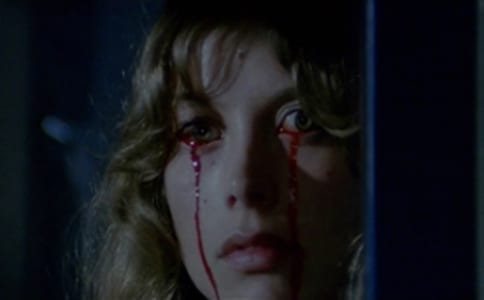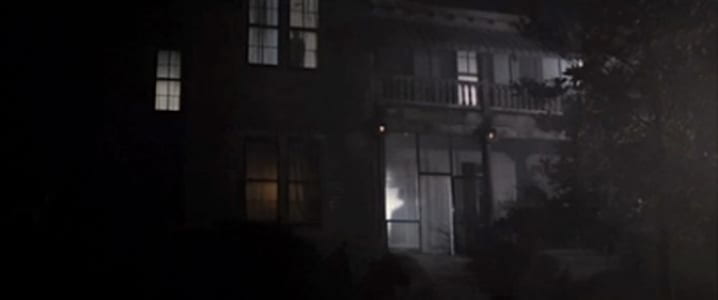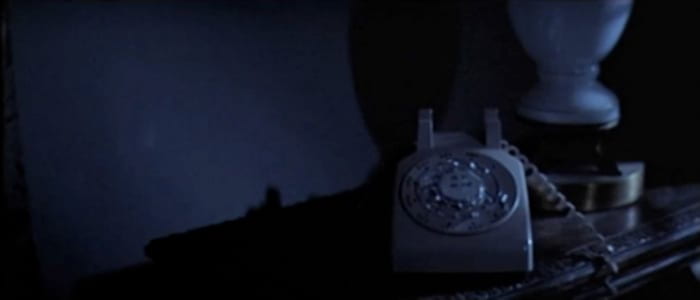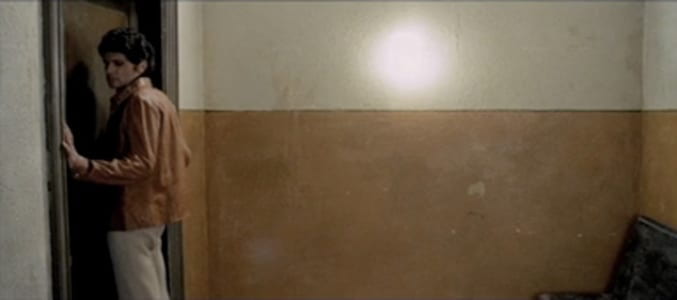
* Originally published at Cinética in February 2014.
Terrorism and reification
Between the cinema and the visual arts, Ben Rivers has created a body of work that overlaps documentary, fiction, installation, and photography, with special attention to the materiality of photochemical film, and a predilection for characters whose lives are intimately connected to a not-always-harmonious relationship with nature, actualizing Thoreau in a way that seems ever more pertinent to contemporary art, including cinema. His first feature film, Two Years at Sea (2011), remains one of the most devoted researches of the creative potential of photochemical film in the past few years (alongside works by Tacita Dean, and the Berlin-based Brazilian duo, Gustavo Janh and Melissa Dullius), recreating the day-to-day life of a character in apparent exile from civilization through the raw potential of 16mm film, accentuating the scratches, noise, grain, and other artifacts acquired in manually processing the film, as a possibility to express a specific experience of the world.
This short summary is just to make the point that Terror!, a short video the director made in 2007 and available on his Vimeo page, couldn’t be more different than all that. One of the River’s few works using video transfers of footage originally captured on 35mm film, Terror! is an appropriation film in which the artist creates a collection of conventions and tropes of horror movies from the 1970s and 1980s. The film was commissioned by a project that borrows its name from the hip hop world: Mixtapes. In the twenty-four minutes of its running time, there is not one single image short by Rivers. His work is limited to selecting and rearticulating short excerpts from other films – some of them pretty recognizable, such as John Carpenter’s Halloweenn (1978), Dario Argento’s Suspiria (1977), and David Cronenberg’s Scanners (1981) – without making any perceptible distinction between them, like a composition made exclusively with samples.
At first glance, Terror! does not seem to be much more than an experiment on post-Deleuzean deconstruction, inventorying and crossing patterns found in the symmetrical shards of a genre that’s been shattered by time. If we take as a principle Deleuze’s own idea that style is difference subordinated to the identical, Ben Rivers starts from the exclusion of difference to privilege sameness, promoting the erasure of style. Since style is an essential tool in genre cinema’s duty to come up with new ways to film the same things without turning them into something else, Ben Rivers first appears to approach this world behind an intellectual shield, refusing the guts until there is only math, removing the difference to make the identical visible.

This movement becomes clear in the film’s first “sequence.” After a short prologue, Terror! lines up wide shots that show the facade of houses that have been used as locations for different horror films. The dark and misty mood flattens the already subtle architectural differences between the buildings (in a chronological inversion, “horror movie house” could become a genre in architecture), borrowing Hitchcock’s strategy to enter a world by cutting to shots that are progressively closer to the dramatic space – a block; a facade; a door; a bedroom – saving little room for differences: a car that drives by, a window that lights up, a silhouette behind a curtain. The editing establishes the typical location of the slasher film, but repetition lends it an unusual weight – the moon; the shadow projected beyond the trees; the lonely light that goes on and off in one of the windows; the silence (sometimes briefly disturbed by music that seems to belong to the original shot, and that is coarsely interrupted once the film cuts to the next shot); the empty porches.
The description of the opening is important because Terror! will stick to this logic of assembly for the rest of its running time. The film strictly adheres to the immutable protocol that gathers elements in thematic blocks: much like the houses, there will be entire sequences of characters opening and closing doors, of props combined to highlight their iconographic potential (a sofa, an armchair, a bedside lamp, a set of keys), and of characters wandering around, calling names out loud, flicking lights off and on, and picking up the phone. This modular approach to the editing becomes clear right in the first few minutes, and it will stay intact during the whole film. But as it moves forward, the meaning generated by this logic changes. If a sequence of different facades put side-by-side calls attention to the protocol that guides the editing, little by little the entrances and exits of unidentified characters in different spaces that are organized as continuous despite belonging to wildly different sources start making the film feel like a maze whose walls are constantly moving. In this place, names get called but nobody ever answers, people are always searching but never finding, and phone calls are restricted to the eternal return of the first “hello.” From that original desire to dismember the elements of the genre, Terror! slowly becomes a horror film, and one as suffocating as any it borrows from.

This process seems to push back against the citational paradigm of postmodernism, starting from the realization of a fragmented world to then use these fragments to assemble something that feels whole. By summing all these “given places” – the term Deleuze uses to describe the train station sequence in Robert Bresson’s Pickpocket (1959) – Ben Rivers creates a space that once again feels like one, mysteriously unbroken. That is its horror. With the filmmaker’s intervention, that exhausted house becomes a kind of magic cube – of many doors, many thresholds, many rooms, many hallways – arranging and rearranging itself so that there is never a way out. If rooms have eyes and ears, there is nothing more invasive than a house with infinite walls.
In this geographic play, the film’s closest sibling is probably Toute une Nuit (1982), one of Chantal Akerman’s most beautiful films. But while the Belgian auteur implodes the particular of fiction through the serial use of faux-raccords creating a form of universal romance – the action one couple starts in one scene is concluded by a different couple in the next scene, joined by the editing trick – Ben Rivers establishes the unity of space and time not through fake continuity, but through a deeper kind of forgery that displays the impossibility of the trick (if I can see it’s broken, why can’t I believe there are cracks?). While the energy of the faux-raccord comes from the indecision before the surprise, from the gap between the belief in the trick and the perception of the illusion, the editing exposes the false from the very beginning, hinting at a continuity that exists beyond the visible. And, still, we believe that this house, this ordinary-movie-looking house, feeds off our faith to grow and grow until it can swallow everything and everyone.
 Rivers calls his collection of horror tropes Terror! – misleadingly, the same word we use for the horror genre in Portuguese. In geopolitical terms that are more pertinent to the anglophonic connotation of “terror,” the challenge posed by terrorism lies in the deterritorialization of war, erasing links with identifiable territories, and suggesting a different kind of authorship that cannot be precisely localized. Terror! enacts that idea by refusing to identify any of its shots, establishing connections that do not belong to the original material, to the point that the responsibility behind the violence(s) of the gesture(s) becomes maddeningly diffuse.
Rivers calls his collection of horror tropes Terror! – misleadingly, the same word we use for the horror genre in Portuguese. In geopolitical terms that are more pertinent to the anglophonic connotation of “terror,” the challenge posed by terrorism lies in the deterritorialization of war, erasing links with identifiable territories, and suggesting a different kind of authorship that cannot be precisely localized. Terror! enacts that idea by refusing to identify any of its shots, establishing connections that do not belong to the original material, to the point that the responsibility behind the violence(s) of the gesture(s) becomes maddeningly diffuse.
This authorial dubiousness touches on a deeper layer imposed by the terrorist gesture in how the film sets up expectations to then subvert them shortly after. Terror! introduces itself as a conceptual work, so that the insecurity and the fear that slowly seep into this rigid structure to the point that it actually becomes a horror film is all the more effective, rebelling against the spectatorial pact established by the film itself. While, at first, the editing seems to focus on the interludes of wait, creating a slow and dispersive anticlimax (at a certain point, the film focuses so much on small domestic actions that it recalls another one of Akerman’s films: Jeanne Dielman, 23 Quai du Commerce, 1080, Bruxelles), nothing could be more surprising than the brutal explosion of gore saved for the end, with violent scenes lined up with the same pathological monotony that organizes the entire film, prolonging the bloody catharsis with an absurd indifference that not even the most graphic horror films seem to dare. In this endless mirror game between the museum piece and the scum of the entertainment industry, Terror!’s method of existence is to sabotage its own stability, to that point that it becomes impossible to differentiate homage and theft, parody and paraphrase, fetishism and reification.
* * *

* Publicado originalmente na Cinética em Fevereiro de 2014.
Terrorismo e reificação
Artista que transita entre o cinema e as artes visuais, o britânico Ben Rivers vem construindo uma obra que ocupa espaço fronteiriço entre o documentário, a ficção, a instalação e a fotografia, marcada pelo manuseio expressivo da película cinematográfica e por uma predileção por personagens e temas cuja existência é intimamente marcada pelo convívio (nem sempre harmonioso) com a natureza bruta, em uma atualização da experiência existencial e filosófica de Thoreau que parece cada vez mais decisiva para a arte contemporânea, incluindo o cinema. Seu longa-metragem Two Years at Sea, de 2011, por exemplo, permanece como uma das mais dedicadas pesquisas sobre os potenciais criativos da película nesses últimos anos (ao lado de alguns trabalhos de Tacita Dean e da dupla brasileira Gustavo Jahn e Melissa Dullius), recriando a rotina de um personagem em aparente exílio da civilização pelo encontro com o potencial bruto de analogia permitido pelo 16mm, acentuando os efeitos da revelação manual e os riscos e pontas dos rolos de filme como possibilidade de expressão de uma experiência de mundo.
Essa breve síntese serve para dizer que Terror!, curta realizado pelo diretor em 2007 e disponível em seu canal no Vimeo, não poderia ser mais diferente de tudo isso. Um dos raros filmes de Rivers que usa o vídeo como suporte, a partir de material originalmente captado em 35mm, Terror! é um filme de apropriação, no qual o artista forma uma espécie de coleção de convenções do cinema de horror dos anos 1970 e 1980 – não à toa, o filme é uma encomenda de um projeto que toma emprestado um termo do hip hop: Mixtapes. Ao longo dos 24 minutos do curta-metragem, não há uma imagem sequer filmada por Rivers. Seu trabalho se resume a pinçar e rearticular pequenos trechos de outros filmes – alguns deles bastante reconhecíveis, como Halloween (1978), de John Carpenter; Suspiria (1977), de Dario Argento, e Scanners (1981), de David Cronenberg – sem fazer qualquer distinção perceptível entre eles, como em uma composição musical a partir de samples.
A princípio, Terror! parece não ser muito mais do que uma experiência de desconstrução pós-deleuzeana, um trabalho de inventariar e cruzar padronagens encontradas nos cacos simétricos de um gênero estilhaçado pela passagem do tempo. Se tomarmos como princípio a máxima do próprio Deleuze de que o estilo seria a diferença subordinada ao idêntico, Ben Rivers parte da exclusão da diferença e para privilegiar do idêntico – ou seja, promove o apagamento do estilo. Como o estilo é ferramenta essencial para o cinema de gênero – que, justamente por seu apego às suas próprias convenções, precisa inventar novas maneiras de filmar sempre as mesmas coisas, sem que as coisas deixem de ser as mesmas -, em um primeiro momento Terror! parece se aproximar desse universo com uma abordagem de fonte intelectual que negue as vísceras até que reste apenas o cálculo, que remova a diferença de forma a deixar aparente o idêntico.

Esse movimento fica claro na primeira “sequência” do filme. Após um curto prólogo, Terror! sequencia planos gerais que mostram as fachadas das casas que servem como locação para diversos filmes de horror. A atmosfera noturna e enevoada acoberta as particularidades arquitetônicas já bastante sutis das diferentes casas (em uma inversão cronológica, “casa de filme de terror” poderia ser um gênero arquitetônico), instaurando a entrada em um universo (na famosa estratégia, muito usada por Hitchock, de usar a decupagem para localizar o espaço de ação e, em seguida, adentrá-lo por meio de planos progressivamente mais próximos – um quarteirão; uma fachada; uma porta; um quarto, por exemplo) que demarca pequenos espaços para diferenças – um carro que passa, uma janela que se acende, um vulto que aparece por trás de uma cortina. Há, neste primeiro movimento do filme, uma decupagem cenográfica de qual seria o espaço do cinema de horror por excelência, e que ganha peso justamente nessa repetição dos mesmos motivos – a lua; a sombra projetada pelas árvores; a luz solitária que se acende ou se apaga em uma das janelas; o silêncio (por vezes quebrado pela entrada da música que parece ser original ao plano, e interrompida quando o filme passa ao seguinte) as varandas vazias.
Essa abertura é importante, pois, de certa forma, Terror! manterá sua lógica de construção e quebrará com sua lógica de sentido no decorrer de sua duração. Manterá, porque a montagem do filme é bastante aderente ao protocolo imutável que determina a reunião de elementos em blocos temáticos: assim como as casas são reunidas em um mesmo bloco, teremos sequências inteiras de personagens abrindo e fechando diferentes portas, outras de objetos de cena reunidos de maneira a ressaltar seu potencial iconográfico (um sofá, uma cadeira, uma luminária, um molho de chaves), e outras ainda de personagens a andar, a chamar outros pelos nomes, a acender e apagar as luzes e a atender o telefone. Há, portanto, uma aplicação de montagem modular que fica patente logo neste primeiro momento e que será mantida ao longo de todo o filme. Ao mesmo tempo, à medida em que ele avança, essa lógica, embora imutável, tem seu sentido transformado. Se uma sequência de fachadas colocadas lado a lado ainda chama a atenção para o protocolo que norteia a própria montagem, aos poucos a entrada e saída dos vários personagens em espaços que, apesar de não serem os mesmos, são organizados de maneira contígua pela montagem, Terror! começa a se parecer com um labirinto de paredes moventes, de perdas e desencontros, de nomes chamados que não respondem, de pessoas buscadas e nunca encontradas, de ligações telefônicas condenadas ao eterno retorno do primeiro “alô”. A partir daquele desejo original de inventariar os elementos de construção de um gênero, Terror! se torna, em si, um filme de horror com uma lógica própria, mas tão sufocante quanto a das fontes que ele solicita.

O que temos aqui é uma espécie de contramão de um suposto pensamento pós-modernista, partindo de procedimentos que já têm o estilhaçamento como base para, a partir deles, reconstituir a impressão de algo uno. Da soma de todos aqueles desconexos “espaços quaisquer” – termo que Deleuze usa para a grande sequência de montage em Pickpocket (1959), de Robert Bresson -, Ben Rivers consegue, pouco a pouco, restituir a sensação de um espaço íntegro, indivisível. Daí, justamente, a atmosfera de horror. Aquela casa – de muitas portas, muitas fachadas, muitos cômodos, muitos corredores – se torna, com o passar do tempo, uma espécie de cubo mágico que se arranja e rearranja para nunca permitir uma saída. Se as paredes têm olhos e ouvidos, nada mais invasivo do que uma casa de paredes infinitas.
terror4
Nesse sentido, o filme que parece mais próximo de Terror! talvez seja Toda uma Noite (1982), um dos mais belos longas de Chantal Akerman. Mas enquanto a diretora belga implode o particular da ficção em um sem número de falsos-raccords – a ação desempenhada por um casal em uma cena pode ser concluída por outro casal, na cena seguinte, transformado em mesmo justamente pelo truque da montagem -, dando a impressão de um grande romance universal, em Terror!, Ben Rivers estabelece uma sensação de unidade espaço-temporal a partir não de falsos-raccords, mas de raccords falsos, criando uma impressão de continuidade impossível (vejo que é quebrado, então como cola?) sem depender do ilusionismo do truque. Enquanto a potência do faux-raccord se guarda no momento de indecisão que antecede a surpresa, do gap entre a crença no truque e a percepção de sua falsidade, a montagem de Ben Rivers expõe a falsidade de antemão, forçando um raccord que é abertamente falso. Ainda assim, acreditamos e esta casa se alimenta de nossa crença para crescer e crescer, até poder engolir a tudo e a todos.

Nesse sentido, é importante um deslocamento proposto por Ben Rivers no título do filme que pode, facilmente, passar desapercebido pelo hábito da língua portuguesa. Pois embora “terror” seja, literalmente, o termo usado para o gênero de cinema no Brasil, em inglês a palavra não tem associação direta com o cinema de horror (horror movies), e sim uma relação muito mais automática e patente com a idéia de terrorismo. O que separa o terrorismo da guerra e impõe a necessidade de novas estratégias de confronto e de controle é a sua completa desterritorialização – ou seja, a ausência de um vínculo direto com um território identificável, com uma noção de autoria que seja localizável com precisão. Terror! se aproxima dessa idéia ao retirar qualquer identificação dos planos reaproveitados pelo filme, provocando ligações e conexões que não estão no material original, de forma que a percepção de quem comanda a(s) violência(s) do(s) gesto(s) se torne no mínimo difusa.
Essa dubiedade esbarra em uma camada mais profunda imposta pelo gesto terrorista, que está na maneira como Terror! propõe expectativas para revertê-las no momento seguinte. Se começamos a assistir ao filme acreditando estar diante de um trabalho conceitual, a insegurança e o medo que vão aos poucos se infiltrando nessa rígida estrutura – por fim, transformando a peça conceitual em um filme de horror verdadeiro – é ainda mais efetiva justamente por se voltar contra a certeza primeiramente estabelecida pelo próprio filme. Se a montagem a princípio parece se pautar pela seleção dos interlúdios de espera, construindo um lento e dispersivo anticlímax (em dado momento, a montagem se concentra em pequenas tarefas domésticas, como fazer ou tomar uma xícara de café, lembrando outro filme de Chantal Akerman: Jeanne Dielman, 23 Quai du Commerce, 1080, Bruxelles, de 1976), nada mais surpreendente do que a reunião, próxima ao final, de uma sucessão violentíssima de momentos do gore mais extremo, enfileirados em uma sequência tão fria, “monótona” e protocolar quanto qualquer outra do filme, prolongando a catarse sangrenta a um limite do absurdo indiferente que nem os filmes de horror mais frontais costumam se permitir. Nesse jogo de espelhos infinito entre a peça de museu e os dejetos da indústria de entretenimento, Terror! implode de tal maneira seu próprio estatuto que se torna impossível diferenciar a homenagem da pilhagem, a paródia da paráfrase, o fetichismo da reificação.






Leave a Reply